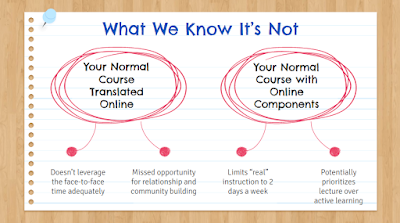This is Part 1 in a three-part series of blog posts on making decisions about what to teach live and in-person while working within a hybrid classroom.
For teachers working within a hybrid model of blended learning right now (students spending part of the week in person and part of the week at home working online to minimize class sizes), the task of teaching in this new environment can feel daunting. I understand the overwhelming feeling of having to be a good full-time in-person instructor while simultaneously being a good full-time online instructor.
However, if we think holistically about the hybrid experience for our students, we can integrate the two modalities to work together instead of against each other. When we do this, we can begin to think about our role as a hybrid teacher as one job and not two disparate and equally time-consuming positions.
So, how do we choose what is online and what is taught in person to maximize our time as teachers and to optimize the learning experience for students?
Our Opportunity
The first step is acknowledging that this can be done well. I have been so inspired by the many teachers I have spoken to who are starting to see success and looking forward to taking what they have learned in this environment with them to their future post-pandemic classroom. Before we were all forced to teach within the constraints of a pandemic, several schools and classrooms experienced success with various blended learning models, including some hybrid options. Teachers across the country explored blended learning as a way to improve academic outcomes for students. There are a lot of examples and case studies to support this type of model to improve learning when implemented with intentionality.
If you are interested in some of these case studies, I encourage you to explore the Evergreen Education Group and the Christensen Institute's collection of case studies and profiles on blended learning successes in K-12 institutions. These districts and schools all demonstrated increased test scores and graduation rates attributed to the redesign of their programs using blended learning.
I want to first remind you that our work with students now, even with the challenges we face teaching during a global pandemic, doesn't have to be subpar. As a matter of fact, there are some things you can put in place now that you might find works better for students. We can adapt these practices and continue to use them when we are operating at capacity again. We all have so much to learn, and it can feel like we are building the plane while it is in the air so-to-speak, but we at least know this learning will help us improve the educational experience for our students moving forward.
What We Know It's Not
So let's start with taking a look at what we know our hybrid structure shouldn't be. Katherine McEldoon, PhD and Emily Schneider, PhD share the two approaches to hybrid learning that we should avoid in their article 7 Tips from Research for Effective Hybrid Teaching. When we do have some in-person time with students, we don't want to create a learning experience that is simply your normal course translated to an online course. We also don't want to just recreate our normal course in the live time we have with students while adding online components.
 |
| This image was taken from a presentation I did with our junior high and high school staff. The slides template I used for the presentation was created by Slidesgo, including images from Freepik. |
It's Not Your Normal Course Translated Online
To meet the needs of both students at home and in your classroom concurrently, you might be tempted to run your class like an online course. Students at home work through online lessons while their peers in class also work through online lessons. In this scenario, you would function almost entirely as an online teacher, overseeing work completion of the students physically in your classroom at any given time.
While we can absolutely create incredible learning experiences for online students, and that is the right environment for some students, it doesn't leverage the face-to-face time you are afforded in this hybrid model adequately. Having time in person with students is a gift.
When we think about the many functions we serve as a teacher, there are certain things that are best done by a live teacher (whether that is live online or live in-person). Stop and reflect about the many jobs you do in the classroom. Which ones can only a trained professional do? Which ones require high levels of human connection? Those are the things we should be doing during our live time with students.
Additionally, when we don't leverage the live time we have with students, we miss an opportunity for relationship and community building. Again, while this can be done online, one of the strengths of the physical classroom is the way in which we can connect with each other in real-time.
Right now students are living through a pandemic and dealing with the implications of that. They are trying to process and live with the trauma caused by the issues of racism that our country is currently facing and has historically always faced. They are being bombarded with the stress and political rhetoric of an election year. All of this plus the additional stressors and trauma that our students may be facing at any other time means there has never been a more important time for us to be building relationships with students and focusing on social emotional learning.
Extensive research shows the importance of relationships. Specifically we know that strong relationships in schools reduce risk factors for our students. We need to keep this in mind as we prioritize our time live with students. How are you making decisions about what is taught in person that helps build connections and community?
It's Not Your Normal Course with Online Components
If we don't feel comfortable with creating learning experiences online, we might also be tempted to try and fit all of our instruction into the limited live time we have with students while giving online homework to complete on the days students are working remotely. This model doesn't work best in a hybrid environment for a couple of reasons.
If we don't shift our thinking to see both in-person and at-home learning time as opportunities for instruction, we will never get through our entire curriculum for the semester or the year. This mindset limits what we consider "real" instruction to 2-3 days a week without leveraging the potential for online learning to provide students with equally as effective instructional experiences.
Additionally, when we try to fit all of our content delivery into limited time, we can often default to all direct instruction being in-person. This can lead to a lecture-based face-to-face learning model. Similar to the thoughts from earlier, if we really sit down and reflect on the most important role we take on as a teacher, lecture with quiet students listening is probably not at the top of the list. Our hybrid model should reflect this.
Two Equal Parts of the Whole
Ultimately, neither modality of learning should exist within a vacuum. To do that, we have to consider what is best done in-person versus online and what needs to be done in real-time versus what students can do with flexibility over time and pace. To find success within a hybrid model, both modes of instruction must be viewed as equally important.
Share your ideas in the comments below or on Twitter using the hashtag #PerfectBlendBook. What is working well for you in terms of your in-person instruction within a hybrid environment? What are you prioritizing for your live face-to-face time with students?
Stay tuned for Parts 2 and 3 where we will dive deeper into models and structures to implement as you optimize your in-person instructional time with students.





